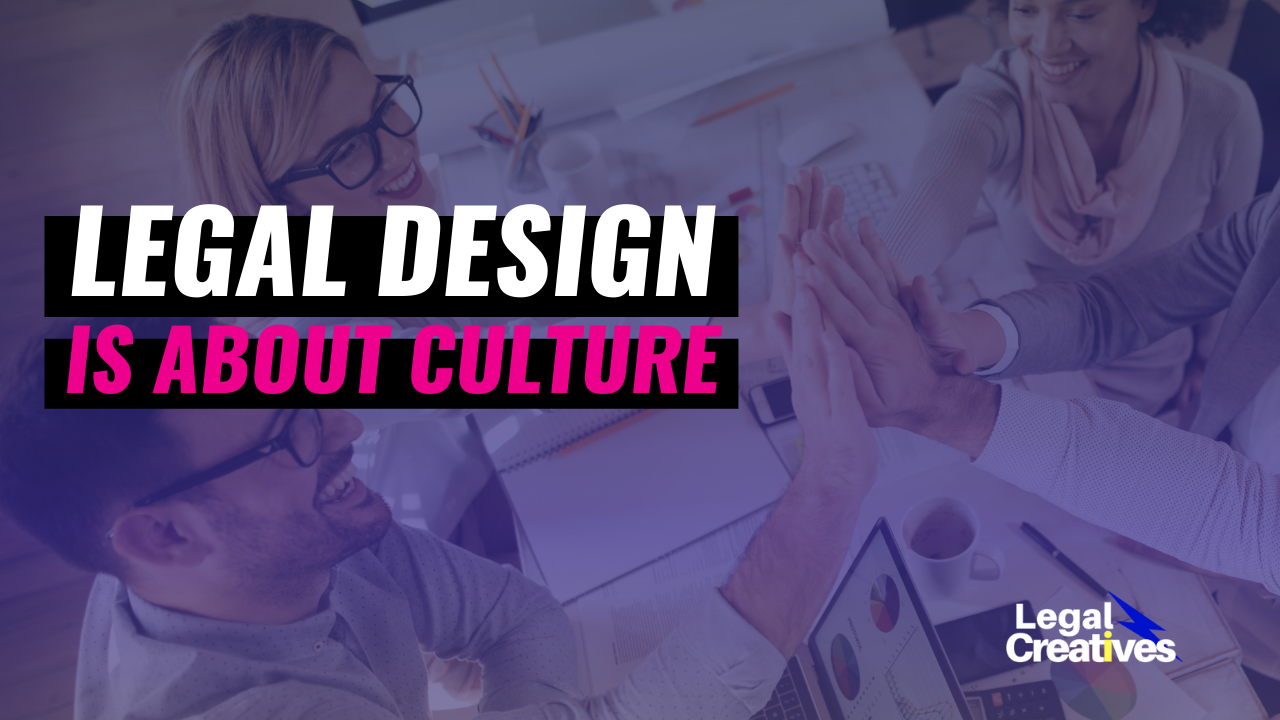Legal Design and Innovation is about culture. Here are 3 tips to help you!
Sep 15, 2021
On my Legal Design and Innovation journey, I came to realize innovation is not about technology. It is about people. It's about mindsets. It is about changing behaviors. And it's about culture.
I will share 3 reasons to explain why Legal Design is about culture. I will also share with you 3 tips to help you implement an Innovation culture in your organization.
1st Argument: Innovation can't be done in silos. You need to bring everybody onboard
If you are trying to innovate alone, you won't get really far. If you don't have much support, you can't blame your boss. You need to be in charge and show that your ideas are worthy. An idea is worthy because it solves a pain point, a problem, a challenge. It should not be a nice-to-have idea, but a "oh-my-gosh why didn't we think of this before" kind of idea. For this reason, you need to investigate the problem, before you even develop and present a solution. Remember that people make decisions to avoid or decrease pain. They'll be more willing to innovate if it can help them reduce or eliminate painful problems than if they perceive this to be a fancy thing to do.
Tip: Investigate the problems. Be a problem finder instead of a problem solver! Collect data and make interviews with colleagues and clients alike to gather insights as to the problems that are harming team efficiency and customer experience. Present the data and insights to the team, pitch the problem you want to solve instead of the solution; and negotiate a window of opportunity to experiment with Legal Design and Innovation. You'll create some space to start a small project - Remember to think big, start small!
2nd Argument: Your lack of practical insights into Legal Design and Innovation is preventing you from keeping up with the new demands of customers.
If you don't have much practice when it comes to Legal Design and Innovation, you can't be persuasive when you pitch innovation. You need to be fully informed on the methodology and properly educated so you can earn the trust you need to move forward with your project. Also, remember that this is not just about you moving forward with your ideas, but solving problems, which means finding the right problem to solve first. The best way to choose which problem to solve first is to focus on what will bring value to customers. In our Certification program at Legal Creatives, we use a matrix to make better decisions that work very well to choose which problem to tackle first. Solving the right problem, taking into account the perspective of the user, always having in mind how to bring more value to customers - this is key. All successful organizations do that, if you're not, you're having a problem - this should be your first problem to solve: Customer-centricity is everything.
Tip: Talk more to your customers. Not to pitch to them. Not to sell to them. But to understand them. Ask questions, be open and curious, as to how they perceive their legal problems and how they experience working with you. Try to portrait how your customers think, build a better relationship with them, communicate more often, not just on their legal matters but on how they perceive you're helping them make progress. Remember to always start with your user.
3rd Argument: Your customer is unaware of how law can be done differently. You're the expert and you are responsible to inform them.
Most of the customers are not informed about Legal Design and are often unaware contracts can be done with visuals and automated with technologies. This new way to deliver legal information brings clarity in relationships and for the business. Customers are rarely going to ask you to innovate in your business - after all you're the expert! They trust you should know. So if you don't say a thing, and your customers spot a Legal Designer posting a Visual Contract on their LinkedIn or on their Instagram and they like it.. they're not even going to ask you. They're going to change service provider and you lose business. It's as simple and harsh as that.
Tip: Educate yourself well so you can plan and conduct a Legal Design project from A to Z. Show real case studies, with numbers and metrics, to demonstrate how powerful Legal Design is. Make sure to have your portfolio ready. You will inspire more trust. if you can show instead of telling.
To finish, it does not matter how much you want to innovate, what matters is if you can collaborate with others. Legal Design can't be done in silos. You need everybody to be on board. And you need your firm and department to make this a culture change.
You can't be the only one in the firm to deliver a new design for contracts if your colleagues stick to legalese. Inconsistency is the most dangerous thing to do for customers. You need to build a culture for Legal Design and Innovation in your teams, departments, and organization.
Talk to you soon
- Tessa Manuello
Founder/CEO Legal Creatives
Ps. Last Sunday, I did something that I never did before. I sat on my desk on Sunday, thinking about how I could help you have more success for the week ahead. So I wrote the first piece of the Founder's Pro Insights and Personal Reflections to our entire community, so I could share some tips and ideas to complement the insights. The feedback I received was incredible. So if you're interested to receive them and you're not yet in our newsletter, please subscribe here.
